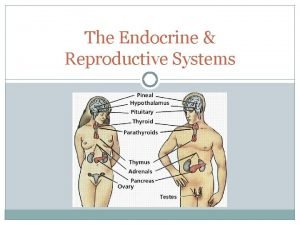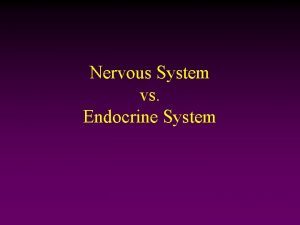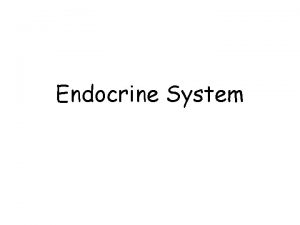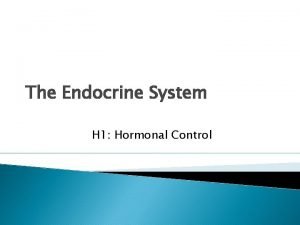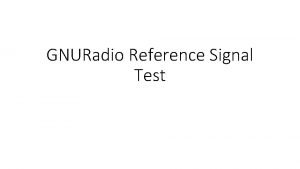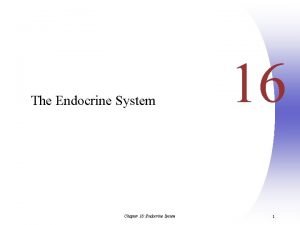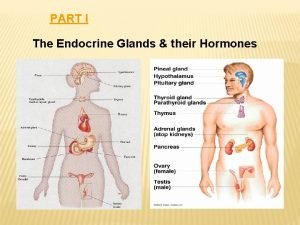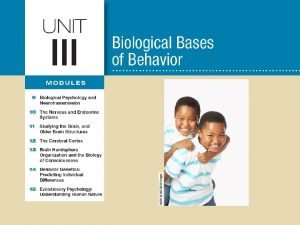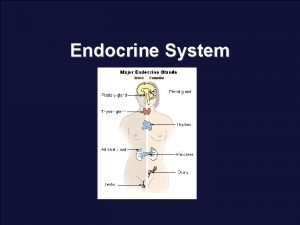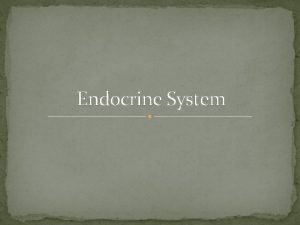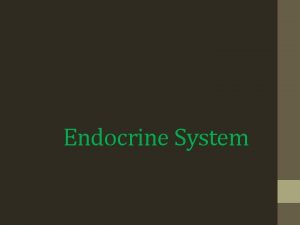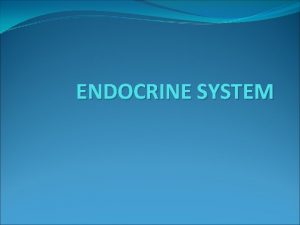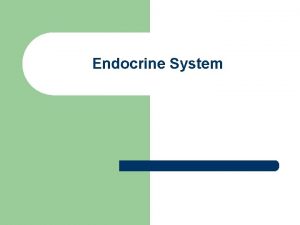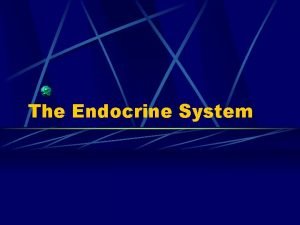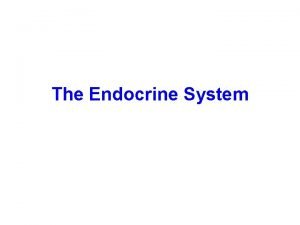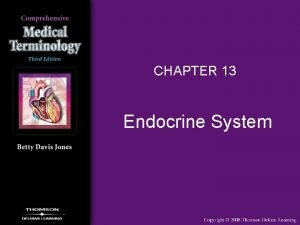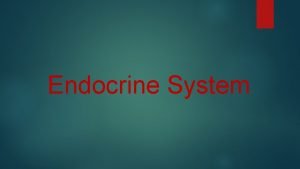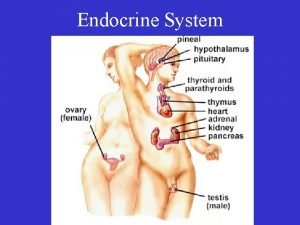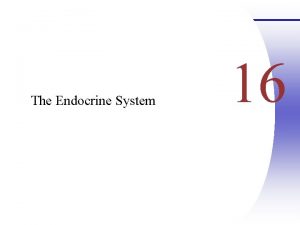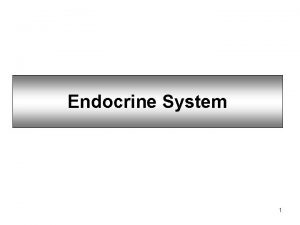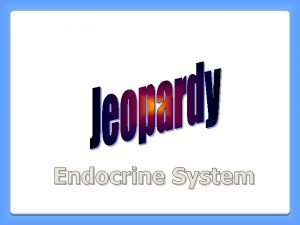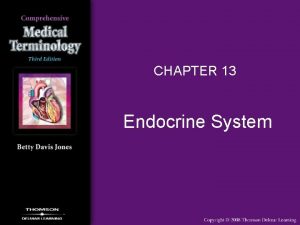Endocrine System Endocrine System ES Endocrine System set







![The Brainstem § Medulla [muh-DUL-uh] § base of the brainstem § controls heartbeat and The Brainstem § Medulla [muh-DUL-uh] § base of the brainstem § controls heartbeat and](https://slidetodoc.com/presentation_image_h2/808e93d5dfd8cab9332f1fbc0c084d05/image-8.jpg)

![The Brainstem § Cerebellum [sehr-uh. BELL-um] § the “little brain” attached to the rear The Brainstem § Cerebellum [sehr-uh. BELL-um] § the “little brain” attached to the rear](https://slidetodoc.com/presentation_image_h2/808e93d5dfd8cab9332f1fbc0c084d05/image-10.jpg)


![The Limbic System § Amygdala [ah-MIG-dah-la] § two almond-shaped neural clusters that are components The Limbic System § Amygdala [ah-MIG-dah-la] § two almond-shaped neural clusters that are components](https://slidetodoc.com/presentation_image_h2/808e93d5dfd8cab9332f1fbc0c084d05/image-13.jpg)



- Slides: 16

Endocrine System

Endocrine System (ES) Endocrine System: set of glands that secrete hormones into the bloodstream • instrumental in regulating: • mood • growth and development • tissue function • metabolism • sexual function • reproductive processes • Snail mail (ES) vs. E-mail (NS) • Responsible for slower processes like cell growth

Endocrine Terms to Know • Glands: a group of cells that produces and secretes, or gives off, chemicals (hormones) – Exocrine glands – ex. Sweat/salivary excrete in a specific sites of the body – Other glands: send chemicals through bloodstream to other cells in the body • Hormones: chemical messengers that transfer information and instructions from one set of cells to another – move through the bloodstream – each type of hormone is designed to affect only certain cells – Can influence our interest in sex, food, and aggression – Some are chemically identical to neurotransmitters

Adrenal Gland • Adrenal Glands: secrete epinephrine (adrenaline) and norepinephrine (noradrenaline) to arouse body in times of stress – Located on top of each kidney • Two parts: – Adrenal Cortex: helps to conserve sodium in the body, increase blood glucose levels, regulate sex hormones such as estrogen – Inner Medulla: secretes epinephrine (aka adrenaline) and norepinephrine in times of stress

Pituitary Gland • Pituitary Gland: ES’s most influential gland; regulates growth and controls other ES glands – **under the influence of the hypothalamus – Growth Hormone Production – Production of Hormones That Act on the Muscles and the Kidneys – Endocrine Function Regulation – Storage of Hormones Produced by the Hypothalamus

Let’s jump over to the brain… Brain hormones pituitary other glands

Brainstem The Brain • the oldest part and central core of the brain, beginning where the spinal cord swells as it enters the skull • responsible for automatic survival functions (breathing, etc. )
![The Brainstem Medulla muhDULuh base of the brainstem controls heartbeat and The Brainstem § Medulla [muh-DUL-uh] § base of the brainstem § controls heartbeat and](https://slidetodoc.com/presentation_image_h2/808e93d5dfd8cab9332f1fbc0c084d05/image-8.jpg)
The Brainstem § Medulla [muh-DUL-uh] § base of the brainstem § controls heartbeat and breathing § Pons § Connects different brain regions together § Involved in facial expressions

The Brainstem § Reticular Formation § a nerve network in the brainstem that plays an important role in controlling arousal § Thalamus [THAL-uh-muss] § the brain’s sensory switchboard, located on top of the brainstem § it directs messages to the sensory receiving areas in the cortex and transmits replies to the cerebellum and medulla
![The Brainstem Cerebellum sehruh BELLum the little brain attached to the rear The Brainstem § Cerebellum [sehr-uh. BELL-um] § the “little brain” attached to the rear](https://slidetodoc.com/presentation_image_h2/808e93d5dfd8cab9332f1fbc0c084d05/image-10.jpg)
The Brainstem § Cerebellum [sehr-uh. BELL-um] § the “little brain” attached to the rear of the brainstem § it helps coordinate voluntary movement and balance § Formulates implicit memories

The Limbic System • a doughnut-shaped system of neural structures at the border of the brainstem and cerebral hemispheres • associated with emotions such as fear and aggression and drives such as those for food and sex • includes the hippocampus, amygdala, and hypothalamus.

The Limbic System
![The Limbic System Amygdala ahMIGdahla two almondshaped neural clusters that are components The Limbic System § Amygdala [ah-MIG-dah-la] § two almond-shaped neural clusters that are components](https://slidetodoc.com/presentation_image_h2/808e93d5dfd8cab9332f1fbc0c084d05/image-13.jpg)
The Limbic System § Amygdala [ah-MIG-dah-la] § two almond-shaped neural clusters that are components of the limbic system and are linked to emotion (specifically aggression and fear)

The Limbic System § Hypothalamus § neural structure lying below (hypo) the thalamus; directs several maintenance activities § Eating and drinking § Sex drive § body temperature § helps govern the endocrine system via the pituitary gland

Hypothalamus Stimulation § Electrode implanted in reward center of hypothalamus § Rat readily crosses to get stimulation

The Limbic System • Hippocampus: a structure in the limbic system linked to explicit memory (Clive Wearing example) • Pituitary Gland: master endocrine gland, linked to growth
 Total set awareness set consideration set
Total set awareness set consideration set Training set validation set test set
Training set validation set test set Endocrine system and reproductive system
Endocrine system and reproductive system Endocrine system vs nervous system
Endocrine system vs nervous system Lympathic
Lympathic General mechanism of hormone action
General mechanism of hormone action Endocrine system
Endocrine system Bounded set vs centered set
Bounded set vs centered set Fuzzy theory
Fuzzy theory Crisp set vs fuzzy set
Crisp set vs fuzzy set Crisp set vs fuzzy set
Crisp set vs fuzzy set What is the overlap of data set 1 and data set 2?
What is the overlap of data set 1 and data set 2? The function from set a to set b is
The function from set a to set b is Major endocrine glands male and female
Major endocrine glands male and female Adenohypophysis
Adenohypophysis Module 10 the nervous and endocrine systems
Module 10 the nervous and endocrine systems Comparison of endocrine and nervous system
Comparison of endocrine and nervous system


